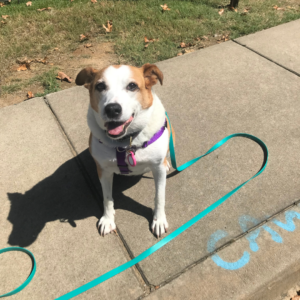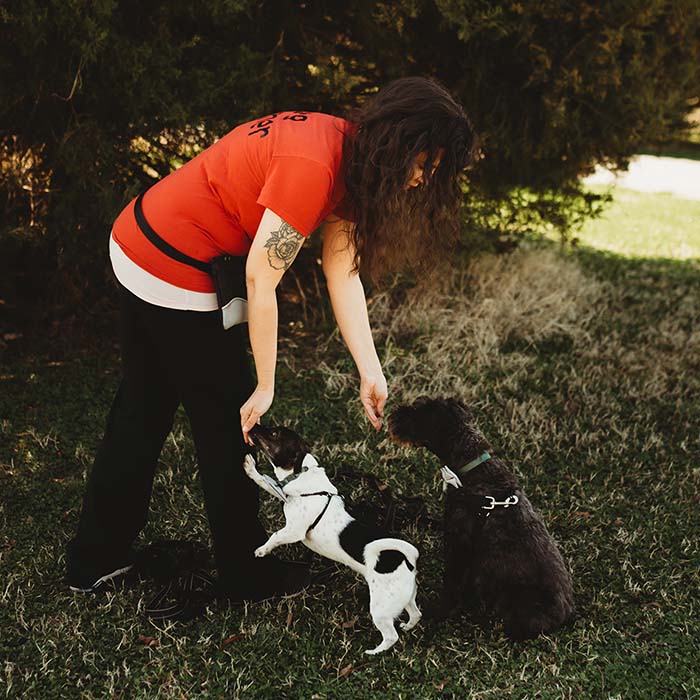Until recently, I didn’t realize that there are some folks who don’t know what’s out there in terms of possibilities for training. A lot of folks in the Little Rock area utilize board-and-trains, but that’s not the only option.
Before moving forward, it’s helpful to understand the types of training available. There’s positive reinforcement, balanced, e-collar training, compulsion, or a mix, to name a few possibilities. The article and podcast linked below with Cassi delves into each a bit more. It’s also helpful to understand the possible repercussions or outcomes of each. Each is part of the four quadrants, all scientifically backed, and part of LIMA. However, depending on the dog, there can be fallout to using aversives. There are a lot of discussions on positive reinforcement vs positive punishment, along with the recent rise of balanced training, which claims to use all four quadrants, but does not always in practice. We’re learning more about how punishment can impact our dogs and our relationship with them. Not all trainers use the punishment quadrants poorly and not all dogs are impacted in the same way. This is why an understanding of the methods and of body language is so important. Once you understand how dogs communicate, you see so much more and can help more effectively.
I discussed training methodologies previously, with Cassi Bee, and you can find that here.
You may also know that you need leash manners, confidence building, aggression management, reactivity work, or general cues, or you know there’s an issue, but you’re not sure how to tackle it, like your dog is having accidents out of the blue, or they have bitten another dog or person.

Starting Out
If you’re not sure what you need, try reaching out to some trainers and asking for guidance. If you’re not sure how to pick a trainer, I have a guide here on what to ask and what to look for. Not all training is equal. Not all trainers are skilled. Not all trainers have the personable side of working with the humans, or the knowledge to adjust training to individual dogs.
It’s also crucial to understand if you actually need training, which is teaching a dog to do or learn something, like waiting patiently at doors. It’s possible you need to schedule a visit with your veterinarian first. Bites, growls, or other big changes in behavior could have roots in medical issues, and it’s important to rule those out. After that, it’s also possible you need behavior modification, and not training. This article explains the differences a bit more. For example, separation anxiety isn’t fixed with training. Behavior modification for separation anxiety (true separation anxiety, not boredom or frustration) requires steps to help a dog feel more comfortable being alone, which isn’t helped with a leash correction or, sometimes, even food. Food used incorrectly can actually sometimes make certain issues worse, and not all behavior modification should include food.
Once those steps are out of the way, and you’ve determined you need some help with training, there some additional options to think about.

Your Choices
1. Nothing. Some issues do resolve themselves, usually things like puppy biting or that insane puppy energy (but not everything can fall into this category). Without a process for establishing incompatible behaviors, like sitting instead of jumping, behaviors that work will most often just simply continue. However, if the behaviors no longer meet a need or work for the dog’s desired outcome, they may resolve on their own. Socialization is super critical for puppies, so even if you don’t do any training, at least consider safe socialization so your puppy can handle the world a bit easier while their brains are still developing. Puppy Socialization, a book by Marge Rogers and Eileen Anderson, is $10 via Kindle and a wonderful guide.
2. Group classes. Best for beginning, general, and advanced obedience. Specialized skills like leash manners, Canine Good Citizen, and puppy socialization. Advanced options like nosework, rally, agility, and personal protection. There are some affordable options in Little Rock and less affordable options. Skill levels and methods vary.
3. In-home lessons. Suitable for individual needs. Best for behaviors that depend on the environment, like anxiety, shyness, or certain types of aggression (aggression may need remote lessons with a specialist, depending on the situation). For example, reactivity or resource guarding may be challenging to handle in a board-and-train situation effectively if those behaviors don’t present in the new environment or it may be difficult to transfer the skills. If you’re not sure you want a person in your home, remote training—for everything from basics to more advanced or complicated needs—is possible.
4. Training walks. I haven’t seen anyone else in central Arkansas offer this, but it’s a big part of my week and a pretty common offering in other parts of the country. This is when the trainer does training session with just them and the dog to work on training and skills. Often, a video is included.
5. Board-and-train. This is a super common option, and this may be best for folks who don’t have the time for intensive training or who may struggle with certain aspects of training. It is best to make sure you understand and accept the training methods used, as locally in central Arkansas this tends to be e-collar, or shock collar, training. It’s also very good if videos are often shared and regular updates are provided. It’s important to understand dog body language, so you can understand how your dog is reacting to the training and you’re getting a dog back who isn’t shut down (also often referred to as “perfect”).
6. Add on training at a doggy daycare. Sometimes it’s convenient to add on if your dog is already going to daycare and may be a good middle option between in-home and a board-and-train. I would recommend again making sure you understand training methodologies and that you get to see what the trainer is doing with your dog. Longer clips (forty-five seconds to two minutes) are best. A 5-15 second video isn’t going to show you much. What does the trainer do if the dog doesn’t understand? How are corrections handled? Also do your research on if doggy daycare is appropriate for your dog, and watch for any behavior changes, however small. I spoke with Nicole of Philly Unleashed on what makes a dog a good fit for a doggy daycare here.
7. Books. I go on a massive book buying spree now and then via DogWise. They have some great titles that are incredibly helpful. A lot of authors like Dr. Patricia McConnell and Jean Donaldson break down behaviors thoroughly, but try to find a professional for more advanced needs, like aggression. It’s easy to get confused over complex concepts and execute it poorly without experience or guidance, but a lot of folks can have a lot of success doing things on their own. I would recommend starting with body language FIRST and nailing the basics before trying to tackle advanced concepts on your own. If you’re on Instagram or Tiktok, My Animal Planets is a great resource to watch a dog and their person work through positive reinforcement, one with service dog training, one with reactivity, along with the process of switching from balanced training to positive reinforcement. I also had Darby on the Telltail Dog podcast, which you can find here.
Body Language
– Doggie Language by Lili Chin
Puppies
– The Perfect Puppy in 7 Days by Dr. Sophia Yin
– Puppy Socialization by Marge Roberts and Eileen Anderson
– The Puppy Primer by Dr. Patricia McConnell
General Understanding (Not Training)
– Excel-erated Learning by Pamela J. Reid
– Don’t Shoot the Dog by Karen Pryor
– The Other End of the Leash by Dr. Patricia McConnell
8. Online. YouTube can be a great option to find some simple help, like KikoPup or Zak George. There are also some wonderful online, free or affordable resources. There are free ebooks meant as sales funnels for everything from puppy potty training to how to stop barking. There are a lot of trainers who offer workshops and free resources, so dig into the #positivereinforcement hashtags on social media and find some folks.
Some of my favorites to recommend are:
– Attention Unlocked
– Every Dog Austin
– Pupstanding Academy *Affiliate link, and you get 25% off with my code, TELLTAIL25*
Remember, this is just a starting point and doesn’t cover all of the options out there! There’s so much good stuff available and plenty that is absolutely wallet-friendly in these inflated times. Do deep dives into content to make sure it’s safe, and reach out if you need some help.



